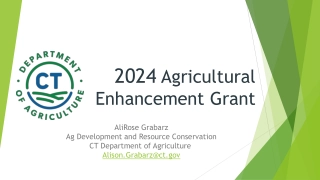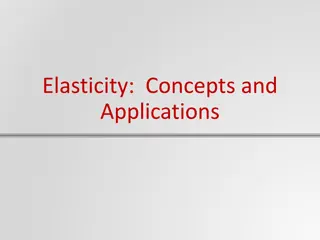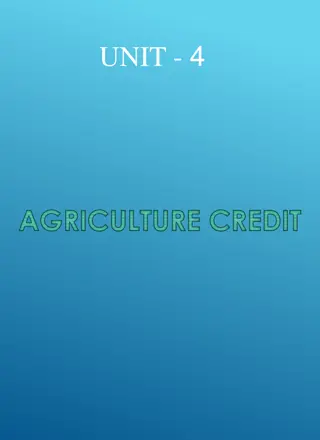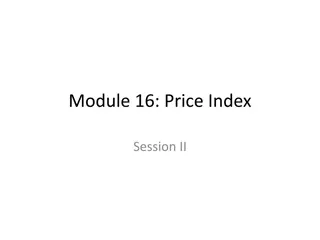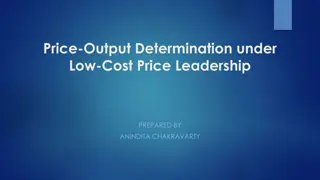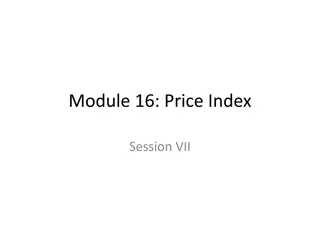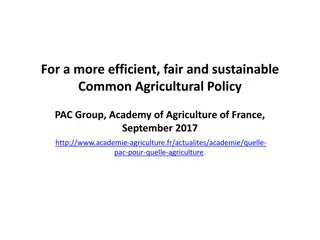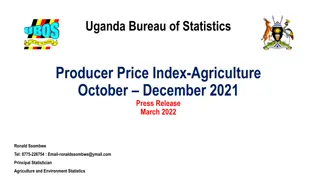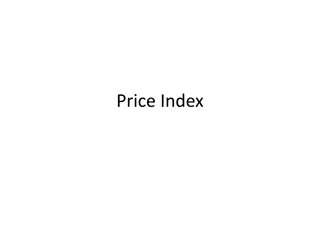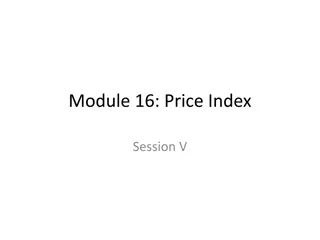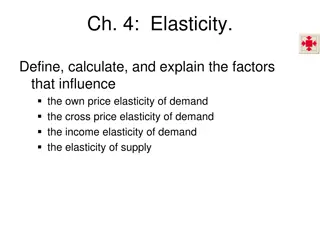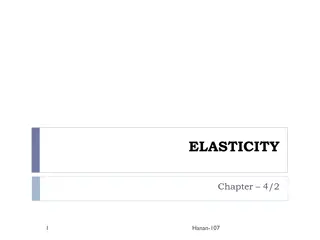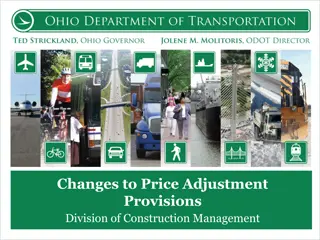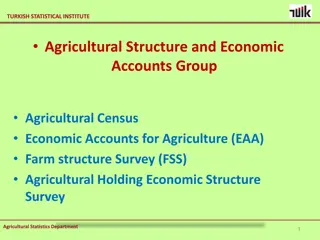Understanding Agricultural Price Policy and Its Importance
Agricultural price policy plays a crucial role in determining, regulating, and controlling prices of agricultural products. Its objectives include preventing violent price fluctuations, ensuring fair prices for farmers, and integrating prices across regions. The policy aims to provide remunerative prices, incentives, and promote capital formation, among others. Various factors affect agricultural prices in India, such as non-remunerative prices, supply-demand dynamics, uncertainty, and middlemen. The government implements procurement and issue prices to manage agricultural pricing effectively.
Download Presentation

Please find below an Image/Link to download the presentation.
The content on the website is provided AS IS for your information and personal use only. It may not be sold, licensed, or shared on other websites without obtaining consent from the author. Download presentation by click this link. If you encounter any issues during the download, it is possible that the publisher has removed the file from their server.
E N D
Presentation Transcript
Agricultural Price Policy Agricultural Price policy means a policy to determine, regulate and control the prices of agricultural products. Objectives * To determine, regulate and control agricultural prices
To prevent violent fluctuations in agricultural prices To promote fair prices for agricultural products to the farmers To provide quality households at reasonable prices goods to
To relationship and balance between the prices of food grain and non-food grain To integrate prices between various states. maintain an appropriate
Need for Agricultural Price Policy 1. To provide remunerative prices 2. To provide incentives 3. To promote capital formation 4. To have better terms of trade 5. To reduce income inequality 6. To prevent inbuilt fluctuations
7. To encourage rational utilization of land Features of Agriculture Prices in India 1. Non-remunerative prices 2. Role of supply in agricultural prices - demand is more or less inelastic but supply depends on good or bad harvest
3. Uncertainty 4. Distress sale 5. Middle men 6. Incomplete information 7. Poor infrastructure
Types of Prices for agriculture by the Government (i) Procurement prices It is the price at which the government purchases agricultural products. (ii) Issue Prices It is the price at which the government sells agricultural goods through fair price shops to poor consumers
Price Policy It was in the context of acute food scarcity during the sixties and the failure of various schemes for food management that the Government of India appointed the Food-grains Prices Committee in 1964 under LK Jha to look under the entire question
of food management in India, and Jha Committee s major contribution was the creation of Food Corporation of India(FCI) and the Agricultural Prices Commission(APC) in 1965.
The FCI and the APC were set up to help administer food security in the country. The FCI is the agency to purchase food-grains at the Minimum Support Price(MSP) and to stock and distribute these to the consumers through the Public Distribution
System (PDS) which consists of as many as 463,000 of fair price shops spread all over the country. The main function of the APC (renamed as Commission for Agricultural costs and Prices in 1985) is to advise the Government on price policy for agricultural commodities.
The Commission is expected to determine and announce administered prices on a yearly basis. Determination of appropriate level of price It depends on a. The cost of production
b. Changes in input prices c. Market prices d. Demand and supply e. Risk factors f. Effect on industrial cost g. Effect on cost of living
h. Effect on general price level i. International price situation j. Party between price of different crops, parity between input and output prices and also between price received by the farmers and paid by the consumers k. Trend of price level in the past
(B) Announcement of administered prices Government announces three types of administered prices (i) Minimum Support Prices Minimum Support Price is the price at which government purchases crops from the farmers, whatever may be the price for the crops.
MSP are of long term guarantee. The prices would not be allowed to fall below the level fixed by the government. So it is like a floor price and guaranteed income to the farmers.
Important cost concepts used by the commission for calculation of MSP are C2 and C3 C2 =actual expenses in cash and kind incurred in production by actual owner + rent paid for leased land + imputed value of family labour + interest on value of owned capital assets + rental value of owned land net of land revenue
C3 = C2+10% of cost to account for managerial remuneration to the farmer Therefor MSP = C = (C2+C3)
Swaminathan formula The M S Swamnathan Committee titled as National Commission on Farmers recommended to fix MSP at level 50 % more than the weighted average cost of production i.e. C2.
MSP is price fixed by Government of India to protect the farmers against excessive fall in price during bumper production years. The minimum support prices are a guarantee price for their produce from the Government.
The objective of the MSP is thus to ensure remunerative growers for by encouraging investment and production. It also aims to bring a balanced realization of sufficient food consumption needs ensuring adequate and affordable food grains to all the people. prices to the higher production at and same the
Thus it served as a floor price and guaranteed income to the farmers. 24 major crops are covered under this scheme. Some of these are Cereals, pulses, oilseeds, raw cotton etc.
(ii) Statutory Minimum Support Price Two commodities Jute and sugarcane has been assigned a statutory status earlier. It means it is illegal for anybody to purchase the commodity at less than its minimum support price.
But inspite of it statutory status, the implementation of statutory minimum price remains unsatisfactory (iii) Procurement Price Procurement price of a commodity refers to the price at which govt. procures the commodity producers/manufactures maintaining the buffer from for
maintaining the buffer stock or the public distribution system. These prices are announced by the govt. of India on the recommendations of the Commission for Agricultural Costs and Prices before the harvest season of the crop.
Procurement prices are fixed generally at a level, which is somewhat higher than the level of minimum support prices but lower than the prevailing market prices.
Procurement prices are announced before the sowing season. procurement price itself become the support price at which the govt. purchased all the foodgrains offered for sale. Procurement prices also become the minimum support prices because the govt. was bound to purchase the foodgrains offered by the producers for sale. As a result, the
(iv) Issue Price These are prices at which the government supplies food grains at ration shops. They are lower than the procurement prices to protect consumer s interest.
(C) Implementation of Administrative Prices (i) Entrusting the task to different agencies (a) FCI Price support operations for most foodgrains (b) Cotton and Jute Corporations of India price support operations for cotton and Jute respectively
(c) National Agricultural Cooperative Marketing Federation (NAFED)- course cereals, pulse and oilseeds (d) Sugar mills to pay minimum prices producers (e) Tobacco Board implementing the price policy
(ii) Establishment of National Crop Forecasting Centre (iii) Setting up of High Powered Price Monitoring Board for monitoring the essential commodity prices and anticipating the need for government intervention in the market (iv) Buffer Stocks FCI and NAFED build-up buffer stocks of essential goods to stabilise the price (v) Warehousing (vi) Regulated markets (vii) Credit Policy
Evaluation of Agricultural Price Policy 1. Difficulty in deciding fair prices 2. No integration between different criteria 3. Benefit to large farmers 4. Mounting fiscal deficits 5. Contribution to inflationary trend
6. Impact on rural poor 7. Bias in favour of low cost states 8. Not all commodities are covered


